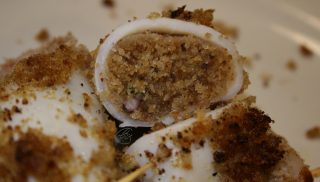VERSIONE IN INGLESE IN FONDO (ENGLISH VERSION AT THE BOTTOM)
Al mercato, Roberta, la mia pescivendola, questa volta mi ha suggerito dei calamaretti che aveva ad un prezzo abbordabile.
Con la mia atavica incapacità di cucinare il pesce (ma con tanta voglia di imparare qualcosa, perché mi piace parecchio) ho chiesto come poterli fare ripieni in maniera semplice.
Mi aspettavo la risposta, ma la chicca l’ha aggiunta una signora che stava comprando anche lei al banco del pesce … Ed ecco il risultato. Ingredienti
Ingredienti
1 Kg e mezzo di calamaretti (poi diventeranno un po’ meno di 1 Kg, ma grazie a Roberta per averli puliti!)
Aglio q.b.
Olio e.v.o. q.b.
Prezzemolo q.b. … ma molto
Poco sale
Pangrattato q.b.
Peperoncino o pepe verde (facoltativo e … q.b.)
Limone
Procedimento
Immagino sappiate tutti come pulire dei calamari; io non sono brava e me lo ha fatto la pescivendola: togliere la pelle, le interiora, senza dimenticare di togliere la spinetta piatta trasparente. Aprire i tentacolini e togliere l’occhio.
Dopo una ulteriore risciacquata accurata del pesce (già pulito al mercato), li ho scolati, separato tutti i tentacolini dal corpo dei calamari (serviranno per il ripieno) e li ho tagliuzzati a pezzettini.
Ho aggiunto anche qualche altro calamaretto intero tagliuzzato, per evitare di appesantire il ripieno con troppo pangrattato.
E qui la chicca della signora al mercato: per poter utilizzare un ripieno già cotto e insaporito, ho preventivamente rosolato in padella il trito di calamaretti con olio, aglio e prezzemolo. Questo ci darà modo successivamente di grigliare (o cuocere in forno) per pochissimo tempo i calamari ripieni, mantenendone tutto il sapore.
Ho cotto a fuoco vivace il trito per pochi minuti a padella scoperta, ho salato poco e messo via (ho tolto l’aglio e il prezzemolo cotti).
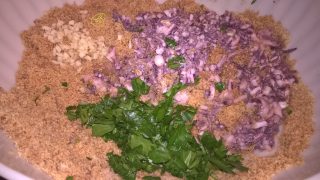
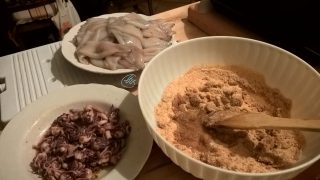 In una terrina, dove avevo versato del pangrattato (la prima volta ne ho messo troppo, ma diciamo che dovrebbe risultare metà/metà col trito e il pesce), ho aggiunto olio per “bagnare” ulteriormente il composto e un nuovo trito abbastanza fine di aglio e prezzemolo freschi. Ho lavorato tutto per un po’ con le dita per sciogliere bene il composto e infine ho aggiunto i tentacoli cotti.
In una terrina, dove avevo versato del pangrattato (la prima volta ne ho messo troppo, ma diciamo che dovrebbe risultare metà/metà col trito e il pesce), ho aggiunto olio per “bagnare” ulteriormente il composto e un nuovo trito abbastanza fine di aglio e prezzemolo freschi. Ho lavorato tutto per un po’ con le dita per sciogliere bene il composto e infine ho aggiunto i tentacoli cotti.
Ho mescolato ancora per bene e riempito moderatamente ciascun calamaretto col ripieno (non esagerare come me, ché poi in cottura si ritirano).
Ho voluto chiudere con stecchini (forse è superfluo: vediamo le prossime prove!)
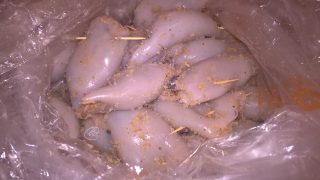
Ho preparato quindi un’emulsione di olio, succo di limone, sale e pepe verde.
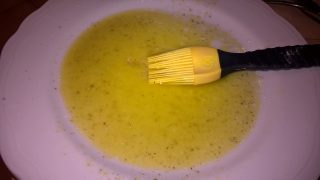
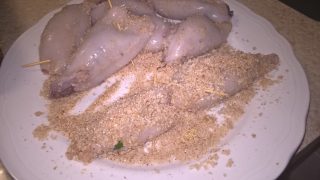
Ho immerso per un po’ i calamari in questa emulsione rigirandoli un paio di volte (volendo possono essere lasciati a marinare per un po’), poi li ho scolati e spolverati per bene con ulteriore pangrattato.
Finalmente la grigliatura per pochi minuti a fuoco vivace sul gas (io sulla griglia di ghisa che intanto stava a scaldarsi da un po’).
In alternativa cuocere preriscaldando il forno a 250°C e impostando una grigliatura delicata per una decina di minuti.
Ricordo che sono teneri e piccolini e il ripieno è già cotto, quindi non vogliono assolutamente una lunga cottura. Li ho rigirati delicatamente a metà cottura e ho servito caldissimi…
Praticamente abbiamo il mare nel piatto: deliziosi!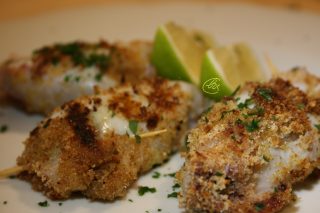
ENGLISH VERSION
At the market, Roberta, the fishmonger, this time suggested me the small squids she had at an affordable price.
With my ancestral inability to cook fish (but with a great desire to learn something, because I like a lot) I asked how to do stuffing in a simple way.
I expected the answer, but the lady next to me, also buying at the fish counter gave me this advice.
Ingredients
1 kg and a half of small squids (then they will become a little less than 1 kg, but thanks to Roberta for cleaning them!)
Garlic as required
Extra virgin olive oil a.r.
Parsley a.r. (a lot!)
Salt (a pinch)
Breadcrumbs a.r.
Chilli pepper or green pepper (optional and a.r.)
Lemon a.r.
Method
I guess you all know how to clean the squids; I’m not good and the fishmonger did it to me: gently remove the entrails, without forgetting to remove the transparent flat spinet. Open the tentacles and remove the eye.
After a further thorough rinsing of the fish (already cleaned at the market), I drained them, separated all the tentacles from the body of the squids (they will be used for the filling) and I chopped them into small piece. I added also some chopped whole squid.
And here the tip of the other customer of the fishmonger: in order to cook for a short time the squids you can cook in advance the ingredients of the stuffing.
to use a stuffing already cooked and flavored, I previously browned the chopped calamari in a pan with oil, garlic and parsley.
I cooked the mince for a few minutes in a frying pan, I salted a little and put away (I removed the garlic and parsley cooked).
In a bowl, where I had poured bread crumbs (let’s say it should be half / half with fish), I added oil to further “wet” the mixture and a new finely chopped mixture of fresh garlic and parsley. I worked everything for a while with my fingers to dissolve the mixture and finally I added the cooked tentacles.
I still mixed well and moderately filled each squid with stuffing (do not overdo it like me, then retreat in cooking).
I wanted to close with sticks (maybe it’s useless)
I then prepared an emulsion of oil, lemon juice, salt and green pepper.
I dipped the squids for a while in this emulsion, turning them a couple of times (if desired they can be left to marinate for a while), then I drained them and sprinkled them well with further breadcrumbs.
Finally grilling for a few minutes on high heat on the gas (I used the cast iron grill that in the meantime was heating up).
As an alternative, cook by preheating the oven to 250 ° C and set a delicate grill for about ten minutes.
I remember they are tender and small and the stuffing is already cooked, so they do not want a long cooking. I turned them gently halfway through cooking and I served very hot …
Basically we have the sea in the pot: delicious!

